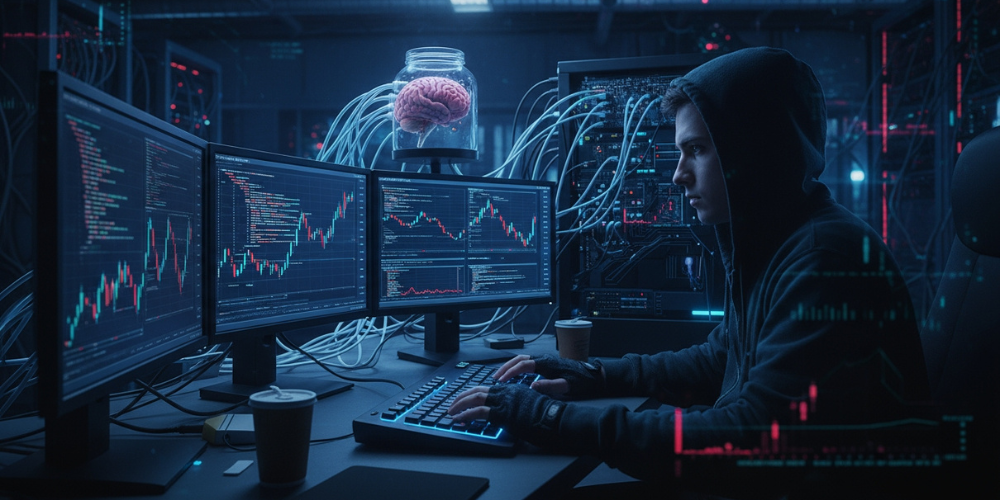Day Trading Rule #6 – Learn To Trade Brain Hack
If I could tell you something that would allow you to spend less time learning to trade AND get you to profit faster, would you want to know what it is?
Of course. But it’s not a setup and it’s not psychology, it’s how you learn and how you don’t.
It’s effectively a “brain hack”.

Think of the brain like 2 computers. You have the “front” computer – the conscious brain, reading these words out loud in your head right now. Then you have the “back computer”, the subconscious mind that keeps your heart beating, keeps you breathing etc.
Research has shown that 350 milliseconds before you think your front computer made a decision, our back computer did it and passed it on. The back computer is 1000x more powerful than the front.
The back computer’s downside – it’s got no keyboard. Ever have an idea pop into your head or wake up with the solution to a problem? That is your back computer delivering an answer (or a joke), whenever it feels like it.
It’s the back computer that does all the work – driving, golf, debating – that’s the part you need to educate and train.
Education – Theory – like “this is how you ride a bicycle”
Training – Skills development – actually learning to ride the bike.
Both require repetition. When I was at school – they’d give us “fill in the blanks” sheets for homework – it would be what they’d taught us and as a kid I thought it was ludicrous. Now I realize it was a reinforcement technique to help it stick in your head.
And
Memories get written permanently to your back computer when you sleep – not when you are actually experiencing them. I flunked exams at 16 and aced at 18 as I’d figured it was a memory test. After each class I’d write condensed notes – which I’d read each day. One thing I noticed was how little was taught in each lesson. The lessons examined ideas, causes and effects – looking at the idea from different angles to help the information embed.
Or they did with most.
My failure at 16 was in the mid-80s, when ADHD didn’t exist—just naughty kids not paying attention. My school reports were a collection of gentle roasts: Physics—”lack of concentration is reflected in the disappointing examination result” (48%, bottom of the pack). Geography? “Rather flippant attitude… written work has suffered accordingly” (43%). English tossed a bone: “He has the ability to do better but only real hard work will improve his position” (59%, still dead last). Music? “Peter has not really worked very hard in music. His talents must lie in other directions” (ouch—clearly I tested her patience with my air-drumming solos).
So if I can do this, you can too. I put a few reports below for your enjoyment (and yes—I did apologize to my parents later. 34 years later, when I was diagnosed with ADHD and I’d only gone in for a shaving cut).
When people come to trading, they tend to overdo it. I recently spoke to a trader that was at his screen 16 hours a day. Trouble is – that’s far too much input to effectively store in your back-computer at night. I’ve had people tell me – I spent all weekend watching your videos.
By doing this – you are not learning, you are absorbing and forgetting information. A video every 2 days is way better than all in a weekend. Let some information in, don’t get drunk or take drugs that night and let it sink in.
Other things that help information sink in:
- Write it down on paper (even if you never read it again – but you should)
- Teach it to someone else (this DOES make you understand something more)
- Keep what you learn to a minimum – encyclopedic knowledge of every trading style is NOT an advantage
One trader I know offered to show me his technique, after 2 hours I asked him to stop. My fear was the knowledge itself would throw me off my game. So we stopped.
Once you are educated, you then need to develop your trading skills. Consider pullbacks. At first you’ll miss them, you’ll get -5 points when +20 are available, you’ll take trades where no pullback exists. As you get better through practice, you’ll get closer and closer to grabbing the opportunity the market is making available to you.
If you do that for 12 hours a day, you’ll have scrambled eggs for brains. It won’t stick, you won’t improve. I get the addiction and that “Grind Culture Doomsayers” have convinced you to spend every waking hour trading – but it’s not aligned with how we learn.
Obviously, everyone is different but here’s some guidelines. Of course, do your own research.
Education – Theory/Absorption Phase
Per Session: 25-50 mins on one topic. Retention tends to drop off after 30 mins
Daily: 1-3 hours spread out into small sessions. At the 4 hour mark almost nothing is sticking
Weekly: 10-15 hours. Cramming more can spike short term recall but long term – zilch
Skills Development – Practice/Reps Phase
Per Session: 45-90 mins. Beyond an hour, error rates climb and adaptations stall
Daily: 2-4 hours max. Top performers (e.g. musicians) cap at 3-5 to avoid burnout
Weekly: 15-25 hours. Steep drop off after 40 hours.
Bottom line: It’s not about grinding harder—it’s hacking the brain’s rhythm. Hit these windows, sleep like a champ, and you’ll embed faster than the 16-hour zombies. If your back computer’s yelling “enough,” listen; that’s the real edge.
FREE BONUS: Take a look into the decision-making process of professional traders with this video training series that helps you make smarter trading decisions.








0 Comments